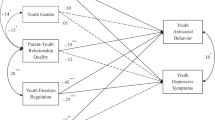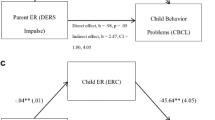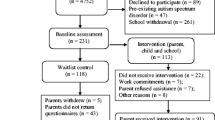Abstract
Among juvenile status offenses, truancy represents the largest share of juvenile court caseloads. As a marker of risk, truancy is important because of its associations with school disengagement, drop-out, and developmental trajectories that include various forms of delinquency and anti-social behavior. Better understanding of the developmental circumstances and needs of truant children may point the way to more effective intervention strategies. Much accumulated research has shown strong associations between the emergence of juvenile delinquency and qualities of caregiving in parent–child relationships. Child-parent attachment in particular has been identified as an important developmental foundation of the child-parent relationship. We used a multi-informant approach to examine associations between children’s self-reported perceptions of attachment security (using the Security Scales), their emotion regulation (reported by parents on the Emotion Regulation Checklist), and school-related behavior problems (as reported by teachers with the Child Behavior Checklist), among 74 elementary school-aged truant children (mean age 9 years). Children and families were recruited through a truancy intervention program in a state in the deep South in the U.S. Data were analyzed via hierarchical multiple regression. Parents’ reports of their children’s emotion regulation predicted behavior problems as reported by teachers. Children’s own reports of their emotional bonds with parents were somewhat less predictive of emotion regulation and behavior problems. Implications for truancy intervention programs for high-risk elementary school children include more focused attention to the importance of children’s developing capacities for emotion regulation and the child-parent bond.

Similar content being viewed by others
References
Achenbach, T. (1991). Manual for the teacher’s report form and 1991 profile. Burlington, VT: University of Vermont, Department of Psychiatry.
American Psychiatric Association. (1998). Diagnostic and statistical manual of mental disorders (4th ed.). Washington, DC: Author.
Balfanz, R., Durham, R., & Plank, S. (2008). Lost days: Patterns and levels of chronic absenteeism among Baltimore City public school students 1999–2000 to 2005–2006. Research report. Baltimore, MD: Johns Hopkins University. Retrieved May 21, 2009, from http://www.baltimore-berc.org/pdfs/Attendance_issue_brief_ FINAL_JULY 2008.pdf.
Batum, P., & Yagmurlu, B. (2007). What counts in externalizing behaviors? The contributions of emotion and behavior regulation. Current Psychology, 25, 272–294. doi:10.1007/BF02915236.
Berger, W., & Wind, S. (2000). Police eliminating truancy: A PET Project. FBI Law Enforcement Bulletin, 69(2), 16–19.
Bowlby, J. (1973). Attachment and loss: Vol. II. separation: Anxiety and anger. New York: Basic Books.
Bowlby, J. (1982). Attachment and loss: Vol. I. Attachment (2nd ed.). New York: Basic Books.
Bretherton, I., & Munholland, K. (2008). Internal working models in attachment relationships: Elaborating a central construct in attachment theory. In J. Cassidy & P. Shaver (Eds.), Handbook of attachment: Theory, research, and clinical applications (2nd ed., pp. 102–127). New York: The Guilford Press.
Cassidy, J. (1994). Emotion regulation: Influences of attachment relationships. In N. A. Fox (Ed.), The development of emotion regulation: Biological and behavioral considerations (Vol. 59, pp. 228–249). Chicago: University of Chicago. (Original work published in Monographs of the Society for Research in Child Development).
Cole, P., Zahn-Waxler, C., Fox, N., Usher, B., & Welsh, D. (1996). Individual differences in emotion regulation and behavior problems in preschool children. Journal of Abnormal Psychology, 105, 518–529. doi:10.1037/0021-843X.105.4.518.
Contreras, J., & Kerns, K. (2000). Emotion regulation processes: Explaining links between parent-child attachment and peer relationships. In K. A. Kerns, J. M. Contreras, & A. M. Neal-Barnett (Eds.), Family and peers: Linking two social worlds (pp. 1–25). Westport, CT: Praeger.
Contreras, J. M., Kerns, K. A., Weimer, B. L., Gentzler, A. L., & Tomich, P. L. (2000). Emotion regulation as amediator of associations between mother–child attachment and peer relationships in middle childhood. Journal of Family Psychology, 14, 111–124. doi:10.1037/0893-3200.14.1.111.
Cooke, M. B., Ford, J., Levine, J., Bourke, C., Newell, L., & Lapidus, G. (2007). The effects of city-wide implementation of “SECOND STEP” on elementary school students’ prosocial and aggressive behaviors. The Journal of Primary Prevention, 28, 93–115. doi:10.1007/s10935-007-0080-1.
Coughlin, C., & Vuchinich, S. (1996). Family experience in preadolescence and the development of male delinquency. Journal of Marriage and the Family, 58, 491–501. doi:10.2307/353512.
Cullingford, C. (1999). Improving school attendance. London: Routledge.
Dekovic, M., Janssens, J., & Van-As, N. (2003). Family predictors of antisocial behavior in adolescence. Family Process, 42, 223–235. doi:10.1111/j.1545-5300.2003.42203.x.
Eisenberg, N., & Fabes, R. (1992). Emotion regulation and the development of social competence. In M. S. Clark (Ed.), Review of personality and social psychology (Vol. 14, pp. 119–150). Newbury Park, CA: Sage.
Eisenberg, N., Fabes, R., Guthrie, I., Murphy, B., Maszk, P., Holmgren, R., et al. (1996). The relations of regulation and emotionality to problem behavior in elementary school children. Development and Psychopathology, 8, 141–162. doi:10.1017/S095457940000701X.
Eisenberg, N., Fabes, R. A., Shepard, S. A., Guthrie, I. K., Murphy, B. C., & Reiser, M. (1999). Parental reactions to children’s negative emotions: Longitudinal relations to quality of children’s social functioning. Child Development, 70, 513–534. doi:10.1111/1467-8624.00037.
Eisenberg, N., Fabes, R., Shepard, S., Murphy, B., Guthrie, I., Jones, S., et al. (1997). Contemporaneous a longitudinal prediction of children’s social functioning from regulation and emotionality. Child Development, 68, 642–664. doi:10.2307/1132116.
Eisenberg, N., Fabes, R., Shepard, S., Murphy, B., Maszk, P., Smith, M., et al. (1995). The role of emotionality and regulation in children’s social functioning: A longitudinal study. Child Development, 66, 1360–1384. doi:10.2307/1131652.
Eisenberg, N., Guthrie, I., Fabes, R., Shepard, S., Losoya, S., Murphy, B., et al. (2000). Prediction of elementary school children’s externalizing problem behaviors from attentional and behavioral regulation and negative emotionality. Child Development, 71, 1367–1382. doi:10.1111/1467-8624.00233.
Eisenberg, N., Losoya, S., Fabes, R. A., Guthrie, I. K., Reiser, M., Murphy, B., et al. (2001). Parental socialization of children’s dysregulated expression of emotion and externalizing problems. Journal of Family Psychology, 15, 183–205. doi:10.1037/0893-3200.15.2.183.
Epstein, J., & Sheldon, S. (2002). Present and accounted for: Improving student attendance through family and community involvement. The Journal of Educational Research, 95, 327–380. doi:10.1080/00220670209596604.
Fox, N. A. (1994). The development of emotion regulation: Biological and behavioral considerations. Monographs of the Society for Research in Child Development, 59(240), 2–3.
Fraser, M. W., Nash, J. K., Galinsky, M. J., & Darwin, K. M. (2000). Making choices: Social problem-solving skills for children. Washington, DC: NASW Press.
Garry, M. (1996). Truancy: First step to a life time of problems. Washington, D.C.: U.S. Department of Justice, Office of Justice Programs, Office of Juvenile Justice and Delinquency Prevention.
Granot, D., & Mayseless, O. (2001). Attachment security and adjustment to school in middle childhood. International Journal of Behavioral Development, 25, 530–541. doi:10.1080/01650250042000366.
Graziano, P., Reavis, R., Keane, S., & Calkins, S. (2007). The role of emotion regulation in children’s early academic success. Journal of School Psychology, 45, 3–19. doi:10.1016/j.jsp.2006.09.002.
Greenberg, M., Kusche, C., Cook, E., & Quamma, J. (1995). Promoting emotional competence in school-aged children: The effects of the PATHS curriculum. Development and Psychopathology, 7, 117–136. doi:10.1017/S0954579400006374.
Greenberg, M., Speltz, M., & DeKlyen, M. (1993). The role of attachment in the early development of disruptive behavior problems. Development and Psychopathology, 5, 191–213. doi:10.1017/S095457940000434X.
Gross, J. J. (2007). Handbook of emotion regulation. New York: Guilford Press.
Gullone, E., & Robinson, K. (2005). The inventory of parent and peer attachment-revised (IPPA-R) for children: A psychometric investigation. Clinical Psychology and Psychotherapy, 12, 67–79.
Guttmann-Steinmetz, S., & Crowell, J. (2006). Attachment and externalizing disorders: A developmental psychopathology perspective. Journal of the American Academy of Child and Adolescent Psychiatry, 45, 440–451. doi:10.1097/01.chi.0000196422.42599.63.
Hallfors, D., Vevea, J. L., Iritani, B., Cho, H., Khatapoush, S., & Saxe, L. (2002). Truancy, grade point average, and sexual activity: A meta-analysis of risk indicators for youth substance use. Journal of School Health, 72, 205–211.
Huizinga, D., Loeber, R., Thornberry, T. P., & Cothern, L. (2000). Co-occurrence of delinquency and other problem behaviors. Washington, D.C.: U.S. Department of Justice, Office of Justice Programs, Office of Juvenile Justice and Delinquency Prevention.
Ingram, R., & Ritter, J. (2000). Vulnerability to depression: Cognitive reactivity and parental bonding in high-risk individuals. Journal of Abnormal Psychology, 109, 588–596. doi:10.1037/0021-843X.109.4.588.
Jr, Mc. Neal., & Ralph, B. (1999). Parental involvement as social capital: Differential effectiveness on science achievement, truancy, and dropping out. Social Forces, 78, 117–144. doi:10.2307/3005792.
Kerns, K. A., Abraham, M. M., Schlegelmilch, A., & Morgan, T. A. (2007). Mother-child attachment in later middle childhood: Assessment approaches and associations with mood and emotion regulation. Attachment and Human Development, 9, 33–53. doi:10.1080/14616730601151441.
Kerns, K., Klepac, L., & Cole, A. (1996). Peer relationships and preadolescents’ perceptions of security in the child- mother relationship. Developmental Psychology, 32, 457–466. doi:10.1037/0012-1649.32.3.457.
Kerns, K., Tomich, P., Aspelmeier, J., & Contreras, J. (2000). Attachment based assessments of parent-child relationships in middle childhood. Developmental Psychology, 36, 614–626. doi:10.1037/0012-1649.36.5.614.
Knitzer, J., & Perry, D. F. (2009). Poverty and infant and toddler development: Facing the complex challenges. In C. H. Zeanah (Ed.), Handbook of infant mental health (3rd ed., pp. 135–152). New York, NY: Guilford Press.
Leifer, M., Kilbane, T., & Skolnick, L. (2002). Relationships between maternal adult attachment security, child perceptions of maternal support, and maternal perceptions of child responses to sexual abuse. Journal of Child Sexual Abuse, 11, 107–124. doi:10.1300/J070v11n03_06.
Lieberman, M., Doyle, A., & Markiewicz, D. (1999). Developmental patterns in security of attachment to mother and father in late childhood and early adolescence: Associations with peer relations. Child Development, 70, 202–213. doi:10.1111/1467-8624.00015.
Loeber, R., & Farrington, D. P. (1998a). Never too early, never too late: Risk factors and successful interventions for serious violent juvenile offenders. Studies on Crime and Crime Prevention, 7, 7–30.
Loeber, R., & Farrington, D. P. (Eds.). (1998b). Serious and violent juvenile offenders: Risk factors and successful interventions. Thousand Oaks, CA: Sage.
Loeber, R., & Farrington, D. (2000). Young children who commit crime: Epidemiology, developmental origins, risk factors, early interventions, and policy implications. Development and Psychopathology, 12, 737–762. doi:10.1017/S0954579400004107.
Moss, E., Rousseau, D., Parent, S., St-Laurent, D., & Sintonge, J. (1998). Correlates of attachment at school age: Maternal reported stress, mother-child interaction, and behavior problems. Child Development, 69, 1390–1405. doi:10.2307/1132273.
Moss, E., & St-Laurent, D. (2001). Attachment at school age and academic performance. Developmental Psychology, 37, 863–874. doi:10.1037/0012-1649.37.6.863.
Puzzanchera, C., Adams, B., & Sickmund, M. (2010). Juvenile court statistics 2006–2007. Pittsburgh, PA: National Center for Juvenile Justice.
Richters, J., & Waters, E. (1991). Attachment and socialization: The positive side of social influence. In M. Lewis & S. Feinman (Eds.), Social influences and socialization in infancy (pp. 185–213). New York: Plenum Press.
Rogers, E., & Lee, S. (1992). A comparison of the perceptions of the mother-daughter relationship of Black pregnant and nonpregnant teenagers. Adolescence, 27, 555–564.
Rosenfeld, L., Richman, J., & Bowen, G. (2000). Social support networks and school outcomes: The centrality of the teacher. Child and Adolescent Social Work Journal, 17, 205–226. doi:10.1023/A:1007535930286.
Saarni, C. (1990). Emotion competence: How emotions and relationships become integrated. In R. A. Thompson (Ed.), Nebraska symposium on motivation: Vol. 36. Socioemotional development (pp. 115–182). Lincoln: University of Nebraska Press.
Schultz, R. (1987). Truancy: Issues and interventions. Behavior Disorders, 12, 117–130.
Shaw, D., & Bell, R. (1993). Developmental theories of parental contributors to antisocial behavior. Journal of Abnormal Child Psychology, 21, 493–518. doi:10.1007/BF00916316.
Shields, A., & Cicchetti, D. (1997). Emotion regulation among school-age children: The development and validation of a new criterion Q-sort scale. Developmental Psychology, 33, 906–916. doi:10.1037/0012-1649.33.6.906.
Thompson, R., & Meyer, S. (2007). Socialization of emotion regulation in the family. In J. Gross (Ed.), Handbook of emotion regulation (pp. 249–268). New York: Guilford.
Verschueren, K., & Marcoen, A. (2002). Perceptions of self and relationship with parents in aggressive and nonaggressive rejected children. Journal of School Psychology, 40, 501–522. doi:10.1016/S0022-4405(02)00122-X.
Wilson, S. (2001). Attachment disorders: Review and current status. Journal of Psychology, 135, 37–51. doi:10.1080/00223980109603678.
Zeman, J., Cassano, M., Perry-Parrish, C., & Stegall, S. (2006). Emotion regulation in children and adolescents. Journal of Developmental and Behavioral Pediatrics, 27, 155–168. doi:10.1097/00004703-00604000-00014.
Zhang, D., Willson, V., Katsiyannis, A., Barrett, D., Ju, S., & Wu, J. (2010). Truancy offenders in the juvenile justice system: A multicohort study. Behavioral Disorders, 35, 229–242.
Author information
Authors and Affiliations
Corresponding author
Rights and permissions
About this article
Cite this article
Kim, H., Page, T. Emotional Bonds with Parents, Emotion Regulation, and School-Related Behavior Problems Among Elementary School Truants. J Child Fam Stud 22, 869–878 (2013). https://doi.org/10.1007/s10826-012-9646-5
Published:
Issue Date:
DOI: https://doi.org/10.1007/s10826-012-9646-5




